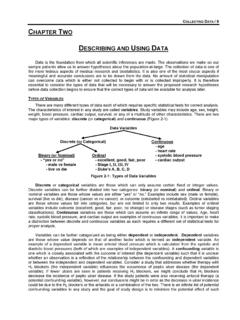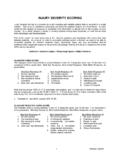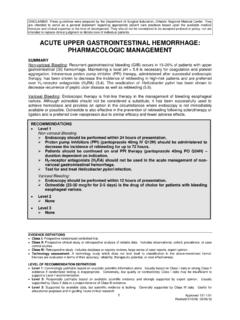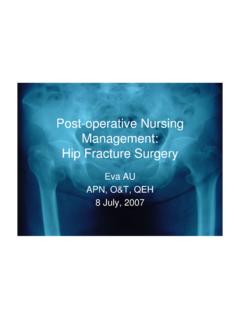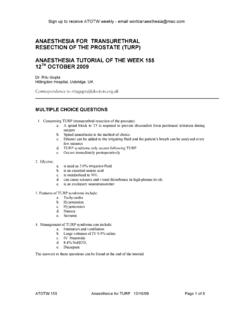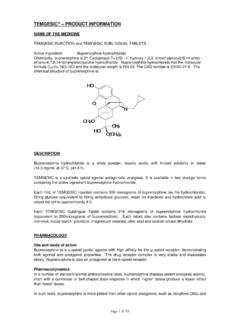Transcription of MULTI-MODALITY PAIN CONTROL FOR RIB FRACTURES
1 DISCLAIMER: These guidelines were prepared by the Department of Surgical Education, Orlando Regional Medical Center. They are intended to serve as a general statement regarding appropriate patient care practices based upon the available medical literature and clinical expertise at the time of development. They should not be considered to be accepted protocol or policy, nor are intended to replace clinical judgment or dictate care of individual patients. EVIDENCE DEFINITIONS Class I: Prospective randomized controlled trial. Class II: Prospective clinical study or retrospective analysis of reliable data. Includes observational, cohort, prevalence, or case CONTROL studies. Class III: Retrospective study. Includes database or registry reviews, large series of case reports, expert opinion. Technology assessment: A technology study which does not lend itself to classification in the above-mentioned format.
2 Devices are evaluated in terms of their accuracy, reliability, therapeutic potential, or cost effectiveness. LEVEL OF RECOMMENDATION DEFINITIONS Level 1: Convincingly justifiable based on available scientific information alone. Usually based on Class I data or strong Class II evidence if randomized testing is inappropriate. Conversely, low quality or contradictory Class I data may be insufficient to support a Level I recommendation. Level 2: Reasonably justifiable based on available scientific evidence and strongly supported by expert opinion. Usually supported by Class II data or a preponderance of Class III evidence. Level 3: Supported by available data, but scientific evidence is lacking. Generally supported by Class III data. Useful for educational purposes and in guiding future clinical research.
3 1 Approved 11/30/2010 MULTI-MODALITY pain CONTROL FOR RIB FRACTURES SUMMARY The pain associated with acute traumatic rib FRACTURES can be difficult to CONTROL . Narcotic medications have traditionally been the mainstay of therapy, but are associated with multiple side effects including respiratory depression, delirium, hypotension, constipation, and development of tolerance and addiction. MULTI-MODALITY pain therapy that includes both non-steroidal anti-inflammatory agents and regional analgesia may result in improved pain CONTROL with less opiate use and decreased morbidity. INTRODUCTION Rib FRACTURES are common injuries among the traumatically injured. While the pain associated with a single rib fracture is relatively easy to CONTROL , the significant pain of multiple rib FRACTURES can be difficult to manage and can lead to decreased pulmonary function, increased hospital length of stay, and increased health care expenditures.
4 MULTI-MODALITY therapy for multiple rib fracture-related pain CONTROL has become increasingly common in recent years with the introduction of intravenous (IV) NSAIDs and regional analgesia using continuous bupivacaine infusions, both of which have been shown to decrease opiate requirements and their related side effects. LITERATURE REVIEW The outcome of traumatic injury is dependent on multiple factors. Injury severity and patient age are two of the strongest predictors of patient survival. Younger patients tend to fare better with injuries that cause RECOMMENDATIONS Level 1 None Level 2 In patients with multiple rib FRACTURES , patient controlled analgesia (PCA) using intravenous narcotics should be instituted at the time of admission. Level 3 In patients with multiple rib FRACTURES , intravenous non-steroidal anti-inflammatory drugs (NSAIDs) should be instituted at the time of admission.
5 Ibuprofen 800 mg IV q 6 hours OR ketorolac tromethamine 15 mg IV q 6 hours Intravenous NSAID therapy should be limited to a maximum of five (5) days When able to take oral medications, patients should be transitioned to oral narcotic and NSAID therapy. Initiate narcotic therapy with the lowest opiate dosage that achieves pain CONTROL . Patients with multiple rib FRACTURES and/or advanced age OR patients who are unable to achieve effective pain CONTROL using intravenous narcotics and NSAIDs may benefit from early insertion of continuous bupivacaine infusion catheter(s) to provide regional analgesia. 2 Approved 11/30/2010 significant morbidity and mortality among older patients. Multiple rib FRACTURES are associated with a significantly increased morbidity and mortality compared to single rib FRACTURES . Bulger et al. showed a difference in mortality of 10% vs.
6 22% in young (18-64 years) vs. old ( 65 years) patients with rib FRACTURES (1). There were also differences in ventilator days ( vs. days), intensive care unit days ( vs. days), and hospital length of stay ( vs. days) among young vs. old patients. Recent data has shown that patient controlled analgesia (PCA) imparts a significant survival advantage in elderly patients with blunt chest trauma (2). This study also demonstrated a protective trend toward improved survival in elderly rib fracture patients with the use of an NSAID agent such as ketorolac tromethamine. IV ibuprofen has recently become available as a non-narcotic adjunct for the treatment of post-surgical and post-trauma pain . Southworth et al. studied the use of IV ibuprofen in a multicenter randomized trial of elective orthopedic and abdominal surgery patients (3).
7 Patients were given IV morphine by PCA and randomized to receive either 400 or 800 mg of IV ibuprofen, or placebo. The first dose of study drug was administered intra-operatively at closure of the surgical wound. It was then given every six (6) hours for the first 48 hours of admission. The drug was then continued at the discretion of the investigator for up to a maximum of five (5) days. Median morphine use was significantly less in the 800 mg ibuprofen group (22% vs. placebo; p= ). Median pain scores were also significantly less in the 800 mg and 400 mg ibuprofen groups compared to placebo. Another recent trial involving elective orthopedic procedures randomized patients to 800 mg IV ibuprofen vs. placebo starting preoperatively and given every six (6) hours (4). The treatment arm had a 26% reduction in visual analog scale (VAS) pain perception scores in the immediate post-operative period.
8 Both treatment groups had access to morphine for breakthrough pain . There was a 31% decrease in morphine usage in the 800 mg ibuprofen group. Drug related adverse events were similar with ibuprofen and placebo. Contraindications to ibuprofen usage include, but are not limited to (5): Known hypersensitivity to ibuprofen or other NSAIDs Asthma, urticaria, or allergic-type reactions after taking aspirin or NSAIDs Peri-operative use in the setting of coronary artery bypass graft (CABG) Precautions for ibuprofen usage Serious and potentially fatal cardiovascular thrombotic events Serious gastrointestinal reactions Hepatic effects Hypertension Congestive heart failure and edema Renal impairment Serious skin reactions (Stevens-Johnson Syndrome, Toxic Epidermal Necrolysis) Regional analgesia for rib FRACTURES has been studied using thoracic epidural analgesia (TEA) and thoracic paravertebral infusion (TPI).
9 Mohta et al. randomized 30 patients to either TEA or TPI with continuous bupivacaine infusion (6). VAS pain scores, respiratory rate, peak expiratory flow rate, and PaO2/FiO2 ratios were measured before and after block administration at regular intervals. Narcotic usage for breakthrough pain CONTROL was tracked. Complications of each method were recorded. Both interventions were found to improve pain scores and have similar complication rates. TEA and TPI, however, can be technically demanding and may require significant patient cooperation which may not be feasible in the intensive care unit. Continuous bupivacaine infusion catheter therapy (On-Q pain relief system, I-Flow Corp, Lake Forest, CA) has been compared with thoracic epidural analgesia. Wheatley et al. compared the On-Q device vs.
10 Epidural analgesia in patients who underwent thoracotomy (7). Continuous bupivacaine infusion achieved better pain CONTROL as evidenced by decreased pain scores and narcotic use with the On-Q device at the incisional area. 3 Approved 11/30/2010 No study to-date has compared the On-Q pump vs. epidural analgesia for rib FRACTURES . The relative ease of placement of this device should provide effective regional analgesia without the risks associated with epidural catheters. The total dosage of bupivacaine infused should be closely monitored to avoid overdose. Significant cardiac depression leading to atrioventricular block, ventricular arrhythmias, and death can result from overdose. Central nervous system depression, stimulation, or both can occur as well. Apparent central stimulation is manifested as restlessness, tremors and shivering progressing to convulsions, followed by depression and coma progressing ultimately to respiratory arrest (8).


